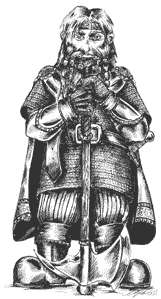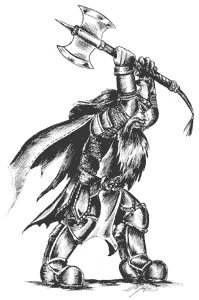Dwarves

Created by Kavak to build and maintain his great citadel of Lima, the dwarves were the first race on Arrasia, where they lived peacefully for countless generations. Later, Voln would betray Kavak and when Lima was destroyed the dwarves were scattered. Many fled Lima and founded new homes in the hills and mountains of Arrasia, while others were driven deep underground, where Grism would lead them against Dyonicos and Xagraxsus in the darkness of the underworld.
The dwarves despise elves, who they believe betrayed them to Dyonicos during the battle for Lima, when Orphus, mistakenly, ordered his elves to fire against the dwarves of Graxber and brought defeat where there might otherwise have been victory. They sought their own revenge during the fall of Layagat, the great elven kingdom of lore, and sacked Urth, sparking a war between the two races. Although over a thousand years have passed, and the elves and dwarves have learnt to live uneasily together, they still find little respect for one another and tensions are always high.
Dwarves speak Dwarven and although accents vary, the dialect does not and all dwarves can communicate with one another no matter where they are from. Few dwarves bother to learn other languages, with the exception of the more well travelled amongst them - usually the merchants who deal with outsiders - who usually know at least at least a smattering of Karnish (or whatever language is most relevant to their needs).
Dwarves are short and stocky and renown for being tough. They nearly always wear their hair long and they take great pride in their beards, which are usually well groomed and often styled and adorned with rings and trinkets. Dwarves stand around 4 to 4-1/2 feet tall, but are stocky and weigh around 160 pounds.
Dwarven Homelands
The dwarves have made their homelands - usually splendid citadels built deep into the side of mountains and hills - all across Arrasia, though mostly around its civilized core, where trade and alliances can be had. They tend to avoid elves, though this is not always possible and tension nearly always exists where the two races live within close proximity - indeed, conflict is not uncommon between them and though this is usually on a small scale, it can occasionally erupt into something bigger.
Dwarven citadels are nearly always on a grand scale, with Lima, the greatest dwarven citadel of all and which was destroyed by Dyonicos, the standard by which all other citadels are judged. Dwarves love precious stones and metals and fill their great chamber with them. The main halls tend to be large affairs, with vast, ornately carved pillars and columns carved out of the rock, where magnificent communal feasts occur, in which all donate and participate and when they will wear their finest and most ostentatious outfits.
Once, large numbers of dwarves dwelt in the Great Barrier Mountains, where Kavak first stood upon Arrasia and built Lima, but numbers there have declined and their citadels destroyed. Indeed, the Great Barrier Mountains are now home to many smashed and derelict dwarven citadels that now house all manner of evil creatures. In more recent times, Hith in particular has unleashed his orc armies against them and still more dwarven homelands have been destroyed and the dwarves displaced. Many new and small dwarven communities have sprung up all over the mountain range, but only the ancient citadel of Ardale now stands as a monument to the great citadels of old, though it is constantly besieged by the minions of Hith.
Further north, in The Great Northern Hills, the dwarves are still numerous and the citadels there - Gryk Thalek, Orthex (both ancient and monumental constructions) and Kandaq (a relatively new citadel, built by the dwarves who have been driven from their homelands in the Great Barrier Mountains) - are home to a large number of dwarves. The emergence of The Northern Territories has seen good trading opportunities open up and the dwarves there have not been slow in taking advantage. Indeed, they have seen the growth of The Northern Territories as essential to their own well-being and are on friendly terms with those that live there. They are also on friendly terms with the gnomes of Rathanak, Daccathan and Unsyr. However, their homelands are under constant attack from the creatures of The Wild Lands and The Steppes of Eris, as well as the more evil dwellers of the valley of Ximennies and Ragmannon Gorge, both of which are infested with orcs and where it is rumored a great demon has made a home for himself.
The ancient citadel of Yarmex, located in the South Downs, stretches back as far as the First Elf-Dwarf war, when dwarves there helped sack the Layagat city of Urth. It is home to the Portal of Caenarvac, through which Uther returned to Damarkan, bringing an end to his war with the dwarves. It is a splendid citadel and much trade passes between them and Karnish, with whom they have very good relations.
Further east, The Malvus Peaks and the Gava Hills are home to large numbers of dwarves, with Ki-Dyer the oldest remaining dwarven found citadel anywhere on Arrasia and both U'gunn and Maccatoa large and splendid examples of dwarven architecture. They are on friendly terms with the gnomes of Siran and Harikir and the halfling enclave of Nendor, but have too often found themselves in conflict with the elves of Yander Hothinbelim and the nation of Uradun, where orcs are common.
The largest population of dwarves used to be found around The Wretched Mountains and The Splendid Hills, where the greatest citadels were also once found, including The Golden Citadel, which was said to be Lima rebuilt. However, the rise of the Black Mage has brought desolation to that area and the dwarves have been driven out of their homes, which have been destroyed. Karadan, Samman, Henna, Xanak and even the Golden Citadel itself have all been destroyed and the dwarves dispersed. Many have traveled south and begun to rebuild - Venaxia and Rathand having recently emerged - or to live in Goyn, while others have headed north into The North Lands. To the west, Ilken, which stood unconquered and unbowed against Amman for hundreds of years, Irith, Owthenus and Kri-Aruk are all great dwarven citadels that have survived the rigors of time.
The White Mountains are home to the arctic dwarves, who prefer smaller communities to their southern brethren. The arctic dwarves live just below the highest and most rugged peaks, in a harsh and tough environment that is almost constantly frozen over and battered with high winds and ferocious storms. However, three great citadels have emerged in the north, home to large numbers of arctic dwarves. Weirnarras, Angkara and Urkurd dominate the smaller communities that surround them, who offer fealty and loyalty to whichever is nearest. The greatest of these is Urkurd, whose influence stretches unchallenged for thousands of square miles. The arctic dwarves tend to keep to themselves and defend their communities from the many creatures they share their mountains with, but have been known to make trade with the people that now live along the coastlines that are overshadowed by The White Mountains.
Far underneath the surface of Arrasia, and especially under The Great Barrier Mountains, can be found the mountain and
dark dwarves, who are at constant war with one another. The mountain dwarves follow Grism and are said to have built magnificent citadels for themselves, hidden deep within the bowels of Arrasia's underworld. The dark dwarves look to Dyonicos and their citadels are said to be dark and vile places. Both the mountain and dark dwarves are also in constant war with the forces of Xagraxsus, with whom they share the dark corridors and caves.
Dwarven Politics and Society
The dwarven realms are dominated by clans, who control and influence large geographic boundaries. The folk of a particular clan are fiercely loyal to their chief, who is generally an exceptional individual, with strong dwarven traits. Because the essential dwarven nature is both lawful and good, there is very little conflict between the clans, who instead prefer to work with one another to defend their citadels and enhance their trading prospects. This is also true of the powerful families - Houses - that make up the political groups of dwarven societies (even ordinary dwarves are loyal to one House or another), despite the fierce locking of horns that can occur. Occasionally, however, dwarven Houses can clash violently when, usually, ancient grudges are renewed or a new chief is being sought. Less rarely, the clans themselves can come to blows.

The clan chief is nearly always a paragon of his community; not only is he the epitome of dwarveness, but also ranks as amongst the most powerful individual within that community. A chief acquires their status through a formal vote of the Houses that make up the dwarven political scenery and who represent the ordinary dwarves that make up the majority of the population. The position of chief is permanent and only upon the death of the present incumbent will another be chosen.
Political dynasties are common within clans, but anyone can put themselves forward for the position of chief, once an official request for nominee's has been announced. During this period - which is a long and protracted affair - the tension and political intrigue is high, with all manner of deals and agreements being made as the votes (each House has exactly one vote) are vied for. However, although anyone can stand as a candidate for chief, it is unheard of anyone other than a nominee from one of the Houses being voted in, since they themselves control the votes.
The ordinary dwarf seems happy to let themselves be ruled in this way, preferring instead to mine for precious stones and metals, which they covet above all else. Many dwarves live in small dwellings carved into the hills and mountains, usually alongside the veins which are being mined and which can become a web of tunnels and shafts. The larger citadels dominate the smaller communities around them that are of the same clan and during times of strife, smaller communities uproot and look for security in the larger, better-defended ones.
Large or small, there is nothing drab or dreary about dwarven homes, which are usually impressive affairs, ornately carved and sprinkled with gold, silver and all manner of precious stones. Dwarves also enjoy nothing more than feasting and their great halls come alive to great communal feasts where they dress up in their finest livery and drink and eat all they can manage.
- Previous
- Next

